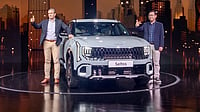After facing a hit in car sales due to supply chain issues last year, Audi India is optimistic to scale good numbers this year. In a conversation with Outlook Business, the luxury carmaker's head Balbir Singh Dhillon says its latest launch Audi RS Q8 is getting a good response from the customers. Edited excerpts:
Audi India's car sales were down last year due to supply chain disruptions. What are your expectations in 2025?
We are doing well this year. We have recently launched Audi RS Q8. It is getting a very good response. The year has started with a good note and I hope we'll continue this growth story going forward as well.
Your pre owned car business is also seeing a good growth. How that has helped the company to upgrade those customers to a new car?
We started building our pre owned car business about four years back. We had only seven showrooms for the pre owned car business. Today, we have 26 showrooms. The growth in this space has been very strong. Last year, we sold over 5,800 new cars. Pre-owned cars reached almost 75% of that number. Now we are reaching that point where many of these customers will be able to move to the next level to buy new cars.
Are you seeing any new trend in terms of customers?
Right now, we have 29 showrooms, 41 workshop, and 26 pre-owned car showrooms. We have 65 plus touch points across the country. Of the total number of cars that we sell, 11% cars are sold to women.
The buyer is getting younger. Also, every fourth car that we sell in the country is sold to our existing customer. So loyalty rate is very strong.
Also, the demand from the younger generation (40% of Audi India’s customers are younger than 40 years) is not just from the tier-1 cities, but also from tier-1, -2 and tier-3 cities. That is also the case for electric cars as well.
Customers come from cities where we don't even have dealerships.
You once said that EV transition for India is not a sprint but a marathon. Is India ready for that marathon?
I still maintain that it's a marathon. It's not a sprint. So the success of electric mobility in India will take time and I think we are in the right direction.
Anybody can question the speed at which it is happening. Success of BEVs depends on four pillars: customer, manufacturer, government and charging infrastructure companies.
From a customer's point of view, it is purely about whether they are ready to accept this technology. There are always apprehensions when you adapt a new technology. We are in that cycle only.
And once we cross this time, then we will reach to the higher volumes.
Now, coming to the manufacturers. Not all the manufacturers in India are yet offering electric cars, but they're in the process. Once everyone has got more and more cars on the road, customers will have more choices. This is the manufacturer's responsibility.
We have only 8,000 to 10,000 charging point as of now compared to over 80,000 fuel pumps in India. And most of these charging points are either AC chargers, which are very slow. We need high speed charging points, of 150 kilowatts and above. This will give customers a comfort of using these cars intercity.
And the fourth and the foremost is the support from the government. They have a clear focus (on EVs), be it through lower tax or financial benefits.
Have you raised the issue of charging infra with the government?
These kind of issues are not raised in one to one meetings but there are common platforms and wherever we have had this opportunity, we have spoken about it to the government and they are looking at it. Every manufacturer will also contribute towards improving the charging infrastructure.
How is Audi India trying to bridge that charging infra gap?
Through the myAudi application, we have tied up with multiple charge point operators. So it's not just the 140 to 150 Audi chargers that customers can see but a thousand plus charges. Customers can also plan their route (to find charging points during travel). They can also pay to the charging station operators. So we are able to help our customers through this.
How do you see the government's efforts to attracting global carmakers impacting your target of achieving 50% sales from EVs?
The government's policy is still in a draft stage. Once the final policy is out, each of the manufacturers will sit down and discuss internally to get those kind of value adds from the government.
But any policy where we can participate and which gives us more strength to reach our BEV goals earlier is always welcome, provided we are able to invest to that extent.
On global manufacturers, I think anybody who's entering the luxury space will only widen the luxury segment. We are operating in a very small segment. It is just about 1.2% of the overall car sales in India.
More manufacturers in the luxury space will only widening the pace of penetration.
It will also give us opportunity to set more cars. Competition is always good for customers because they get wider choices, and then they bring more customers.
Are you looking at increasing local component sourcing for your assembly unit?
We keep evaluating things and see what better we can do. It all depends upon the volumes are we selling, the kind of opportunities we have to localize. So it is a constant evaluation.


























